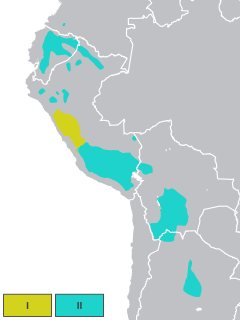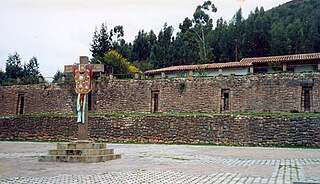
Quechua, usually called Runasimi in Quechuan languages, is an indigenous language family spoken by the Quechua peoples, primarily living in the Peruvian Andes and highlands of South America. Derived from a common ancestral language, it is the most widely spoken language family of indigenous peoples of the Americas, with a total of probably some 8–10 million speakers. Approximately 25% of Peruvians speak a Quechuan language. It is perhaps most widely known for being the main language of a family of the Inca Empire. The Spanish colonisers initially encouraged its use, but from the middle of their reign they suppressed it. However, Quechua ultimately survived, and variants are still widely spoken today.

The aguayo, or also quepina is a rectangular carrying cloth used in traditional communities in the Andes region of Argentina, Bolivia, Chile, Colombia, Ecuador and Peru. Aymara and Quechua people use it to carry small children or all kinds of items in it on their backs. It is similar to a lliklla and sometimes regarded as a synonym.
Mawk'allaqta, also Mawk'a Llaqta is an archaeological site in Peru. It is located in the Cusco Region, Espinar Province, on the border of the districts Coporaque and Suykutambo. Mawk'allaqta is situated on the banks of the Hank'amayu and the Apurímac River at a height of 3,915 metres (12,844 ft).

Tarahuasi is an archaeological site in Peru. It is located in the Cusco Region, Anta Province, Limatambo District.

Incahuasi or Incawasi is an archaeological site in Peru. It is located in the Lima Region, Cañete Province, Lunahuaná District.
Mawk'allaqta, also Mawk'a Llaqta is an archaeological site in Peru. It is located in the Puno Region, Melgar Province, Nuñoa District. The site was declared a National Cultural Heritage (Patrimonio Cultural) of Peru by the National Institute of Culture.
Mawk'allaqta, also Mawk'a Llaqta, is an archaeological site in Peru. It is located in the Puno Region, Sandia Province, Sandia District. The site was declared a National Cultural Heritage (Patrimonio Cultural) of Peru by the National Institute of Culture.
Mawk'allaqta or Mawk'a Llaqta is an archaeological site in Peru. It is located in the Cusco Region, Paruro Province, Paccaritambo District, near Mullipampa (Mollebamba).

Colcampata is an archaeological site in Peru. It is situated in the Cusco Region, Cusco Province, Cusco District.
Waqutu is an archaeological site in Peru. It is located in the Cusco Region, Cusco Province, in the districts San Jerónimo and Saylla.
Khichuqaqa is an archaeological site in Peru with rock paintings and tombs nearby. It is situated in the Cusco Region, Urubamba Province, Urubamba District. The site lies at a height of about 3,160 metres (10,367 ft) on the slope of the mountain Kapuliyuq.

Purunllacta or Purum Llacta (Quechua purum, purun savage, wild / wasteland, llaqta place is an archaeological site of the Chachapoya culture in Peru. It is situated in the Amazonas Region, Chachapoyas Province, Cheto District, on the mountain of the same name. It lies northeast and near the archaeological site of Purunllacta of the Soloco District.

Purunllacta or Purum Llacta (possibly from Quechua purum, purun savage, wild / wasteland, llaqta place is an archaeological site in Peru. It is situated in the Amazonas Region, Chachapoyas Province, Soloco District, southwest and near the archaeological site of Purum Llaqta of the Cheto District.

Kunturmarka is an archaeological site in Peru. It is situated in the Ayacucho Region, Huanta Province, Huamanguilla District.
Quriwayrachina, Quri Wayrachina, Hatun Quriwayrachina or Hatun Quri Wayrachina is an archaeological site of the Inca period in Peru located in the Ayacucho Region, Lucanas Province, Carmen Salcedo District. It lies near the mountain Inka Pallanka which is venerated as an apu by the people of the area. There are two platforms which are known as Hatun Quri Wayrachina and Huch'uy Quri Wayrachina by the locals. On April 20, 2011, the site was declared a National Cultural Heritage by Resolución Viceministerial No. 459-2011-VMPCIC-MC.
Quriwayrachina or Quri Wayrachina is an archaeological site with agricultural terraces in Peru. It is situated in the Cusco Region, Anta Province. The terraces lie about 4 kilometres (2.5 mi) north of the terraces of Zurite.

Maray Qalla is an archaeological site in Peru. It is situated in the Ancash Region, Carlos Fermín Fitzcarrald Province. Maray Qalla lies at a section of the Qhapaq Ñan, the Inca road system.

Awkimarka is an archaeological site in the Apurímac Region in Peru. It lies on a mountain of the same name which reaches a height of about 4,000 metres (13,123 ft). It is situated in the Apurímac Region, Andahuaylas Province, on the border of the districts of Pomacocha and Tumay Huaraca.

Tinyaq or Quri Willka is an archaeological site in Peru with storehouses of the Inca period on a mountain named Tinyaq. It is located in the Ayacucho Region, Huanta Province, Iguain District.
Inka Raqay hispanicized spelling Incaraqay) or Allqu Willka(Allcuhuillca, Alkowillka) is an archaeological site in the Ayacucho Region in Peru. It is located in the Huanta Province, Iguain District, on top of the mountain named Allqu Willka.










